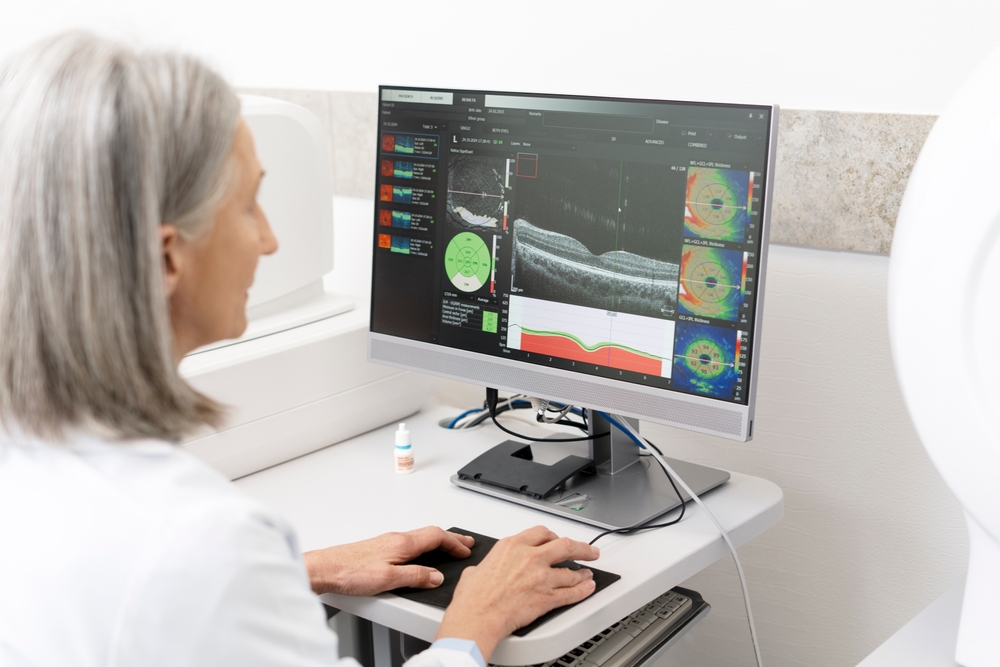How Is Retinal Imaging Different from a Regular Eye Exam?

How Is Retinal Imaging Different from a Regular Eye Exam?
When it comes to protecting your vision and maintaining lifelong eye health, you may be familiar with the importance of regular eye exams. But have you ever wondered how retinal imaging fits into the picture? Although both a regular eye exam and retinal imaging are essential tools for your eye doctor, they serve different purposes and together, they provide a more complete understanding of your eye health.
What Happens During a Routine Eye Exam?
A comprehensive eye exam includes a series of tests to assess your eyesight, check for refractive errors like nearsightedness or astigmatism, and evaluate the overall health of your eyes. Your optometrist will also examine the external and internal structures of your eyes, looking for signs of disease or abnormalities.
Typical components of a regular eye exam may include:
• Visual acuity testing: Measures how well you see at different distances.
• Refraction assessment: Determines your exact prescription for glasses or contacts.
• Eye muscle testing: Checks for proper eye movement and alignment.
• Slit-lamp examination: Provides a magnified view of your eye’s front structures.
• Dilated eye exam: Expands your pupils so your optometrist can examine the back of your eye, including the retina and optic nerve.
While these tests are comprehensive, some conditions or changes within the retina can be subtle and difficult to detect without more advanced technology.
What Is Retinal Imaging?
Retinal imaging uses specialized digital technology to take high-resolution pictures of the back of your eye, specifically the retina. This quick and painless procedure allows your eye doctor to see a detailed, cross-sectional view of the retina, blood vessels, and optic nerve using advanced tools like Optical Coherence Tomography (OCT) and Optos imaging. OCT provides precise cross-sectional images of the retina’s layers, helping detect even the smallest changes or early signs of disease. Optos imaging offers ultra-widefield images, capturing a much larger view of the retina in a single shot.
With retinal imaging, your optometrist can:
• Detect early signs of eye diseases, such as glaucoma, macular degeneration, and diabetic retinopathy.
• Monitor changes in the retina over time for patients with chronic conditions.
• Document and compare images year after year for more precise tracking.
Unlike a traditional dilated eye exam, retinal imaging can reveal even the smallest changes or damage that may not be visible with standard methods.
Why You Need Both
Retinal imaging and regular eye exams are complementary, not interchangeable. A comprehensive eye exam gives your optometrist a full picture of your vision and eye health, identifying refractive errors and checking the health of both the front and back of your eye.
Retinal imaging offers a level of detail and documentation that goes beyond what can be seen through the microscope alone. It can help catch early warning signs of potentially sight-threatening conditions - sometimes before you notice any symptoms.
Having both procedures performed regularly means your optometrist can:
• Detect problems earlier
• Track changes more accurately
• Provide you with the most thorough care possible
Schedule Your Next Eye Exam with Retinal Imaging Today
Annual eye exams and retinal imaging each play a vital role in maintaining your eye health. While a traditional eye exam covers the basics of vision and eye structure, retinal imaging allows for early detection and monitoring of diseases that could threaten your sight. By having both, you’re taking a proactive approach to preserving your vision for years to come.
Prioritize your eye health by scheduling a comprehensive eye exam and advanced retinal imaging at Texas State Optical. Contact our office in Cypress, Texas, by calling (281) 758-0008 or visiting tsocypress.com to book an appointment today.







